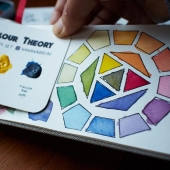
 9
9











 3
3























Herein, we show that natural honey is immiscible with vegetable oils at ambient temperature, making them suitable candidates for emulsification. When emulsified with colloidal particles like precipitated CaCO3 (Socal R1E FG, Calofort U and Calofort SV), the mixtures gave stable vegetable oil-in-honey emulsions.
...
For instance, because honey is naturally sweet, these emulsions can be used in the formulation of novel food products without adding sweeteners. Furthermore, the emulsions can be used as bread, biscuit, or cracker spread, that is, as a substitute for margarine that has an appreciable fat content. In addition, these emulsions can be used for microencapsulation of water-labile food and pharmaceutically active ingredients.




 3
3











 3
3











 3
3




Nicole Alderman wrote:Reading your first post again, it seems that the problem seems to be the paint pigment not sticking to itself and to the paint tray? This is watercolor paint in trays (like kids use in school), rather than watercolor paint that comes out of tubes, right?
It seems like there's nothing really holding the pigment together in a "cake" (I think that's the right word?). Honey is sticky, and seems to help hold fats together, so it might also help keep the pigment together.
Maybe try your experiment on just one (the most fragile) of the water colors. The chemical make-up of that particular pigment might just not be as "sticky" as the other pigments, and so its more prone to crumbling and falling apart. Adding the honey probably wouldn't hurt (though I would worry about it molding. I've found that honey when diluted with water or other foods does mold. But pigment doesn't usually mold, so maybe it won't be a problem?)







 4
4




Gum Arabic Solution
Gum Arabic is a watersoluble gum which is extracted from the acacia tree, and it acts as the glue that binds the pigment. Some artists make their own by dissolving gum Arabic pieces in distilled water, but we also stock gum Arabic solution which is ready to use.
Honey
Honey is an ingredient in many ranges of watercolour, including our own Jackson’s Artist Watercolours. It is a humectant which helps the paint retain moisture and re-wet after drying. Honey is also a natural preservative and a plasticiser, meaning that it increases the flexibility of gum Arabic (a naturally brittle binder) and prevent cracking in the pan after drying. Runny honey is best, rather than the harder variety.
Glycerin
Like honey, glycerin is a humectant and a plasticiser which can be bought at a pharmacy (it is a common ingredient in skincare products). I used both honey and glycerin in my binder because I find too much honey to be very sticky, but either glycerin or honey would work on its own.
Clove Oil
A natural antibacterial and antifungal agent, clove oil (usually sold as clove essential oil) is an excellent preservative which stops the paint going mouldy.
Dry Pigment
Our new range of Artist Pigments consists of 100 colours, all of which are suitable for making handmade watercolours. 10g is enough to make around 1-2 full pans of watercolour (depending on the pigment), so it is an ideal size if you are trying out a new colour. For larger volumes of paint, they are also available in pots of 100g.







 2
2




 3
3











 4
4




Roxanne ...AKA Wilde Hilde
"Ensnar'd in flowers, I fall in the grass."-Marvell
 3
3











 2
2




They differ from one another because natural dyes are colored pigments that can dissolve in a liquid and adhere to a surface by chemically bonding with it. Earth pigments are insoluble in water and adhere to a surface through the use of a binder
....
By definition, earth pigments are insoluble in water and are physically and chemically unaffected by the mediums they mix with. Earth pigments come from naturally occurring minerals, typically iron oxide or manganese oxide. Through the process of grinding, geological material can become a pigment powder
Gum arabic is used as a binder for watercolor painting because it dissolves easily in water. Pigment of any color is suspended within the acacia gum in varying amounts, resulting in watercolor paint.
 3
3











 3
3











 4
4
















